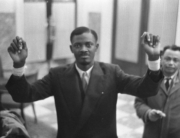Two episodes of reckoning play out in Stephen Wilkes’s moving documentary. The first takes place when celebrated photographer Jay Maisel reunites with an intern he mentored almost 40 years earlier. “How old are you?” he demands. “I’m 57,” answers the former protégé. “God, you’re old,” blurts out the 88-year-old man. “That’s frightening!” All of us can relate to that dizzy feeling evoked by a sudden stare down into time’s abyss.
The second encounter with the past is the turning point that brings the two men face to face again. Maisel is moving out of a towering building at 190 Bowery, a 72-room behemoth where he has stored massive quantities of his photographs and collections of objects obsessively harvested over nearly half a century. The intern is now a filmmaker, here to pay tribute to his mentor and observe the end of an era: “I knew I had to capture Jay’s world before it disappeared.” What could be one more lament to vanishing Old New York gets a welcome shot of astringency, thanks to Maisel’s gruffness and eccentricity.
And his talent. Maisel is a dynamo who never stops creating or letting the perfect moment for an image find him. The film celebrates his brilliant, wide-ranging career, which saw him shoot for Sports Illustrated, capture countless celebrities, exhibit in multiple galleries, and indulge a lifelong obsession with saturated color. Of particular note are Maisel’s portraits of ordinary people, which radiate an almost Norman Rockwell–esque optimism. According to his peers, Maisel was a shrewd businessman as well as a restless spirit.
In the 1980s, his acumen and daring led him to invest $102,000 in an enormous old bank building at a neglected corner of Bowery and Spring. Splashed by graffiti and looking abandoned, the building looms over the neighborhood and the narrative like a craggy, living character, a stronghold Maisel calls “a source and a drain for my energy.” Today, of course, the neighborhood is wealthy, safe, and bland, a place where high property taxes and upkeep costs have forced Maisel to abandon the castle. The artist reflects that once he had little money and lived as if he had a lot; now he has a lot of money, but he can no longer afford to live that way. It’s a conundrum many New Yorkers may recognize.
As Maisel and Wilkes reminisce, cameras take in the giant proportions of the elegant, cluttered space. They intimately meander down halls and linger by windows, dwelling on assemblages from the fanciful (jewel-like stones, shimmering glass) to the dumbfounding (piles of old table legs). Movers start to pack away precious objects and leave spaces denuded. Maisel jokes, kibitzes and reflects. “Part of being a photographer is being a collector,” he says, and images, assemblages, and 4,800 drawers full of toys, papers, and curios pile up in an overwhelming testimonial to an artistic life fully chronicled. The space also functions as a personal and lived-in design rebuke to the trendy “curated” minimalism that will no doubt take its place.
Jay Myself tends to go a little easy on its subject. Maisel’s collection mania veers awfully close to hoarding, and a joke about his thinking he has Alzheimer’s disease because he can’t find lost objects falls flat. In this building, who the hell could find anything? Maisel refers to his own childlike state approvingly, but living with a grown-up child is rarely easy. His wife seems toughened, his young adult daughter Amanda wistful. “He doesn’t make sense as a parent,” Amanda says, before dutifully adding, “But he’s a good one.” And the bittersweet nostalgia of seeing the manor emptied out is muted by the sum Maisel and family will receive for the property: $55 million, reputedly the biggest residential deal in Manhattan history.
It takes 35 moving vans to wheel away Maisel’s treasures, and he takes pictures down to the wire on his last day on the premises. He carefully lights and photographs a large assortment of wooden artificial hands, marveling at the pattern they make and the imprints they leave. It’s a fitting moment of an existence spent creating and a quiet contradiction to one of the artist’s remarks: “One of the hardest thinks to photograph is the passage of time.”







Leave A Comment